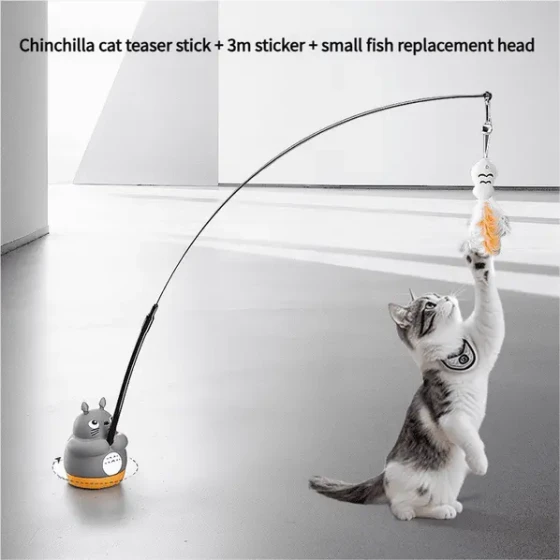Will Feline Panleukopenia Infect Humans_Understanding the Real Impact of Feline Panleukopenia on Humans
Feline panleukopenia is a highly contagious disease primarily affecting felines, and it usually does not infect humans. The feline panleukopenia virus has species specificity, mainly spreading among cats. Although humans do not contract the feline panleukopenia virus, after contact with infected cats or contaminated environments, the virus may be transmitted to other susceptible cats through humans' clothing or hands. Therefore, maintaining hygiene and avoiding cross-infection are crucial to prevent the spread of feline panleukopenia within cat populations.

What is feline panleukopenia?
Feline panleukopenia, also known as feline distemper (Feline Panleukopenia), is an acute and highly contagious disease caused by the feline parvovirus (Feline Parvovirus, FPV). This virus mainly attacks rapidly dividing cells in cats, especially cells in the intestines, bone marrow, and lymphatic tissues, causing severe symptoms and even death. Kittens, unvaccinated cats, and cats with weakened immune systems are high-risk groups.
Can the feline panleukopenia virus infect humans?
This is a common concern among cat owners, and the answer is: the feline panleukopenia virus usually does not infect humans. The feline parvovirus has a clear species specificity; it mainly infects felines. Although some studies show that feline parvovirus and canine parvovirus may bind and enter cells by interacting with human or cat transferrin receptors at the cellular level, this does not imply the virus can effectively infect or spread within humans. Humans do not become infected by the feline panleukopenia virus or exhibit related symptoms.
How is the feline panleukopenia virus transmitted?
The feline panleukopenia virus mainly spreads through the following ways:
- Direct contact: Healthy cats come into direct contact with blood, urine, feces, saliva, vomit, or nasal secretions of infected cats.
- Indirect contact: The virus is highly resilient in the environment and can survive for months or even a year under suitable conditions. Cats may get infected by contacting contaminated food bowls, water bowls, litter boxes, toys, bedding, cages, or human clothing, shoes, and hands.
- Mother-to-offspring transmission: Pregnant cats infected with feline panleukopenia can pass the virus to their fetuses through the placenta, potentially causing stillbirth, miscarriage, or neurological symptoms (such as cerebellar hypoplasia) after birth.
- Parasite transmission: Blood-sucking insects like fleas may also carry the virus and transmit it between cats.
Even indoor-only cats may get infected through owners bringing the virus home on shoes, clothing, or other items from outside.
Common symptoms of feline panleukopenia
The incubation period of feline panleukopenia usually ranges from 2 to 7 days, sometimes up to 10 days. During the incubation period, cats may show no obvious clinical symptoms, but the virus is already replicating and spreading inside the body. Once the disease manifests, typical symptoms include:
- High fever: Body temperature may rise above 40°C, possibly dropping to normal or lower levels in later stages.
- Lethargy, loss of appetite or refusal to eat: Cats become very weak, inactive, and lose interest in food.
- Persistent vomiting: Frequent vomiting with yellow-green mucus, sometimes with blood streaks in severe cases.
- Diarrhea: Soft stools; severe cases may have watery or bloody diarrhea.
- Dehydration: Due to frequent vomiting and diarrhea, cats rapidly become dehydrated, showing decreased skin elasticity and sunken eye sockets.
- Sharp decrease in white blood cells: A key feature of feline panleukopenia, making cats susceptible to secondary bacterial infections.
- Other symptoms: Sticky secretions in the mouth, eyes, and nose; abdominal pain; trembling; ataxia (especially cerebellar hypoplasia in kittens); and even seizures.
Note that some cats infected with feline panleukopenia may have mild or no symptoms and may even suddenly die, especially kittens. Even vaccinated cats can be at risk if vaccination is incomplete or maternal antibodies interfere.
How to prevent feline panleukopenia?
The most effective way to prevent feline panleukopenia is timely vaccination. The feline panleukopenia vaccine is considered a core vaccine for all cats.
- Kitten vaccination: Kittens receive maternal antibodies through nursing after birth, but this protection wanes over time. It is generally recommended to start vaccinating kittens at 8-12 weeks of age, administering one dose every 3-4 weeks for a total of 3 doses, with the last dose given after 16 weeks of age.
- Adult cat booster: Adult cats usually require annual booster shots.
- Avoid exposure to infection sources: Minimize contact between your cat and stray or unfamiliar cats.
- Environmental disinfection: The virus resists many disinfectants but can be inactivated using diluted bleach (84 disinfectant), formalin, or glutaraldehyde with sufficient exposure time.
- Personal hygiene: After interacting with other cats, especially in panleukopenia-prone areas, wash hands and change clothes before handling your own cat to avoid becoming a viral carrier.
- Isolation of new cats: Newly introduced cats should be quarantined and observed for a period before mixing with other cats.
Treatment of feline panleukopenia
There is currently no specific cure for feline panleukopenia; treatment is primarily supportive to help cats through the critical period relying on their immune system to clear the virus. Treatment usually includes:
- Fluid therapy: Correcting dehydration and electrolyte imbalances through intravenous fluids is crucial.
- Antiemetics and antidiarrheals: Medications to control vomiting and diarrhea, reducing discomfort and dehydration.
- Antibiotics: Preventing and controlling secondary bacterial infections.
- Nutritional support: Providing easily digestible, nutritious food once the cat is able to eat.
- Panleukopenia monoclonal antibodies/interferons: Used early in disease, may help inhibit viral replication and boost immunity.
Treatment is often challenging and requires professional veterinary care, especially for critical patients who may need 24-hour monitoring. Early detection and treatment are vital for improving recovery rates.
Frequently Asked Questions
- Can feline panleukopenia infect dogs? Generally, the feline panleukopenia virus (FPV) does not infect dogs. However, some variants of the canine parvovirus (CPV), such as CPV-2a, CPV-2b, and CPV-2c, can infect cats and cause feline panleukopenia. Fortunately, the feline panleukopenia vaccine offers some cross-protection against infections caused by canine parvovirus.
- What symptoms will humans show after contact with the feline panleukopenia virus? Humans do not get infected with the feline panleukopenia virus, so no symptoms related to feline panleukopenia appear. If discomfort occurs, it may be due to psychological factors, allergies, or other reasons and medical consultation is advised.
- How long can the feline panleukopenia virus survive on human clothes or hands? Although the virus cannot infect humans, it can survive for a short time on human clothing or hands, serving as a transmission medium to other cats. Survival time depends on environmental factors such as temperature and humidity; it may survive for hours to days in dry conditions and months in moist environments. High temperatures and ultraviolet light accelerate virus inactivation.
- Can cats get feline panleukopenia again after recovery? Cats that recover from feline panleukopenia usually develop lasting immunity to the same virus strain and are unlikely to be reinfected. However, prevention of other diseases remains necessary.
- Are there sequelae after feline panleukopenia recovery? Most cats recover without sequelae; damaged intestines and white blood cell counts gradually return to normal. However, kittens infected in utero with cerebellar hypoplasia may have permanent neurological issues.
Summary
Feline panleukopenia is a very dangerous infectious disease for cats, but fortunately, it does not pose a direct threat to humans. As responsible cat owners, understanding its transmission routes and prevention methods is essential. The most effective prevention is timely vaccination, coupled with environmental and personal hygiene to avoid bringing the virus home. This provides a safe and healthy living environment for our beloved cats. Remember, timely veterinary care and professional treatment are the best strategies against feline panleukopenia; avoid blind self-treatment to prevent worsening the condition.



